Screen recording is the act of capturing the content displayed on a screen in real time.
Due to its ease of use, screen recording has become one of the most prolific forms of video piracy over the last several years. As a result, content creators and distributors alike often turn to DRM for answers. Digital Rights Management (DRM) was originally designed to control access to content so that only those devices which had been delivered a DRM license would have the rights to view it. Even if a piece of content that had been encrypted with DRM was able to be downloaded and shared, the other device would also have to obtain a DRM license to view it. DRM is well suited for this use case and to this day provides excellent levels of protection for this scenario.
Some of the other, lesser-known features of DRM also address the issue of screen recording. The details though can be a bit murky and might hamper the user experience of those that had no intention of piracy at all.
In this article, we will explore the key factors that affect screen recording and DRM, discuss the challenges associated with different approaches, and highlight the importance of considering the overall impact when deciding to use DRM to prevent screen recording.
Let's begin by understanding what screen recording actually means.
What is Screen Recording?
Screen recording refers to the process of capturing the content displayed on a screen in real-time. This can be accomplished using various tools such as software applications or hardware devices. Common methods of screen recording include utilizing dedicated applications, browser plugins, live-streaming software like OBS, or even recording the screen with a camera.
For instance, on a Macbook, one can use the built-in QuickTime Player to record content being played on a Google Chrome browser. It's important to note that Chrome for Desktop and Firefox for Desktop offer only Google Widevine L3 security level, which is a software-based digital rights management (DRM) solution.
Unfortunately, these easily accessible techniques have created opportunities for digital pirates to unlawfully record and distribute copyrighted content.
Now, why is it crucial for the industry to address the issue of screen recording?
Implications of Screen Recording
Screen recording carries significant implications for content providers, presenting numerous challenges for both content owners and service providers. Here are some key implications to consider:
- Violation of Intellectual Property Rights: Screen recording undermines the intellectual property (IP) rights of content providers and creators, as they have little control over how their content is consumed. This not only diminishes the value of their brand but also deprives them of the recognition and rewards they deserve for their creative work. Imagine the countless hours and effort put into developing a movie, only for it to be enjoyed without appropriate compensation.
- Revenue Loss: Screen recording allows users to capture and reproduce digital content without obtaining permission from the content provider. This can lead to the unauthorized distribution and sharing of copyrighted material, resulting in substantial financial losses for content providers. The ability to easily record and share content hampers their ability to monetize their work and sustain their business operations.
Screen recording severely threatens content providers' revenue and intellectual property rights. It emphasizes the need for effective measures, such as Digital Rights Management (DRM), to prevent unauthorized screen recording and protect the interests of content providers.
Stopping Screen Recording with DRM
What is DRM?
DRM, or Digital Rights Management, is like a lock and key for digital content. It's a technology that content creators use to protect their movies, music, books, and other digital files from being copied or shared without permission.
It restricts how the content can be accessed and used, ensuring that only authorized people can enjoy it. Think of it as a way to safeguard the hard work of artists and creators by preventing others from freely distributing their content without permission.
Read our whitepaper for a detailed description of how DRM works.
Can DRM Stop Screen Recording?
DRM technologies like Widevine, PlayReady, and FairPlay Streaming can help prevent screen recording, although it's important to acknowledge that the only way to offer foolproof protection is at the expense of user experience.
These DRM systems leverage hardware-based security mechanisms, such as Trusted Execution Environments (TEE) or Secure Media Path, to establish a secure chain of trust from the content provider to the end-user device, thereby deterring unauthorized screen recording.
Let's explore how different security levels in Widevine, FairPlay Streaming, and PlayReady contribute to the prevention of screen recording:
Widevine:
Widevine, developed by Google, offers different security levels: L1, L2, and L3. Each level provides varying degrees of security and protection against screen recording.
Widevine Security Level L1 offers the highest security and is effective at preventing screen recording. It utilizes special hardware features in devices, such as TEE or Secure Media Path, to ensure secure playback of content.
With Widevine L1, the content remains protected within the device's hardware components, such as the GPU, display, or video decoder, while being played. This prevents screen recording software from capturing the content during playback.
On the other hand, Widevine Security Levels L2 and L3 do not possess the same level of hardware-based security as L1, making them more vulnerable to screen recording exploits as they rely on software-based security measures.
PlayReady:
PlayReady, developed by Microsoft, also offers different security levels. PlayReady SL3000, designed for premium content, incorporates robust measures to prevent screen recording. It relies on secure hardware components, similar to Widevine L1, to protect content during playback.
FairPlay Streaming:
FairPlay Streaming, developed by Apple, also employs hardware-based DRM to effectively block screen recording.
Widevine L1, FairPlay Streaming, and PlayReady SL3000 rely on secure hardware-based playback pathways to thwart unauthorized access and interception of content.
It is important to note that determined individuals or advanced screen recording techniques may still find ways to circumvent DRM measures. Content providers and DRM technology developers continuously work to enhance security measures and stay ahead of new screen recording methods.
DRM is not the sole approach to prevent or deter screen recording. Another technique we will explore next is Forensic Watermarking and how it can be utilized.
Using Forensic Watermarking
Forensic watermarking is like a secret fingerprint that can be embedded into digital content, such as videos or images. It's invisible to our eyes, but it serves as a unique identifier that can help identify the source of unauthorized copies.
While it may not directly stop screen recording, it is a powerful deterrent and helps catch those who try to distribute unauthorized recordings.
In practice, forensic watermarking embeds an invisible identifier within the content itself. So, when someone tries to record the screen while watching a movie or video, that hidden identifier is captured along with the content. Even if the person shares the recorded video online, the content owner can detect the watermark.
This is helpful because it acts as a warning to those who want to record and share content illegally. If they know the content has a hidden watermark, they'll think twice before distributing it. They know that if they get caught, the watermark can be used to trace it back to them.
Additionally, forensic watermarking provides evidence. If someone does record the screen and shares the content without permission, the watermark can be used to prove that it came from a particular source. This helps the content owner take legal action against those who violate copyright laws.
Other Techniques to Prevent Screen Recording
In addition to DRM technologies, there are other techniques that can be employed to prevent or deter screen recording. Let's explore two such techniques:
1) Restricting Playback on Incompatible Browsers and Devices:
One approach is to prevent playback of content on specific browsers and devices that do not support hardware DRM. This can include low-end devices or browsers like Google Chrome, for example. Instead of allowing playback, a message can be displayed to the user, suggesting they switch to a compatible device or browser that supports the necessary hardware DRM.
2) Video Quality Restriction:
Another strategy employed by several streaming services, such as Netflix, is to restrict the video quality available for streaming on certain browsers, such as Google Chrome. By not allowing 1080p or higher quality streaming on these browsers, it serves as a deterrent to screen recording.
These techniques complement DRM technologies by adding additional layers of protection and deterrence against screen recording.
However, it is important to note that determined individuals may still find ways to bypass these measures. Therefore, content providers need to continuously assess and update their strategies to stay ahead of evolving piracy methods.
Conclusion
In the digital landscape, preventing screen recording is crucial for content creators to protect their intellectual property and curb unauthorized distribution.
Using techniques such as watermarking, encryption, resolution limitations, and secure playback environments, screen recording can be effectively prevented on various devices. DRM technologies like PlayReady, Widevine, FairPlay have proven their effectiveness in safeguarding content from unauthorized capture and distribution.
With cutting-edge DRM technologies coupled with Forensic Watermarking, we can foster a secure and sustainable digital ecosystem where content creators can thrive, and audiences can enjoy premium content while respecting the rights and efforts of the creators.












